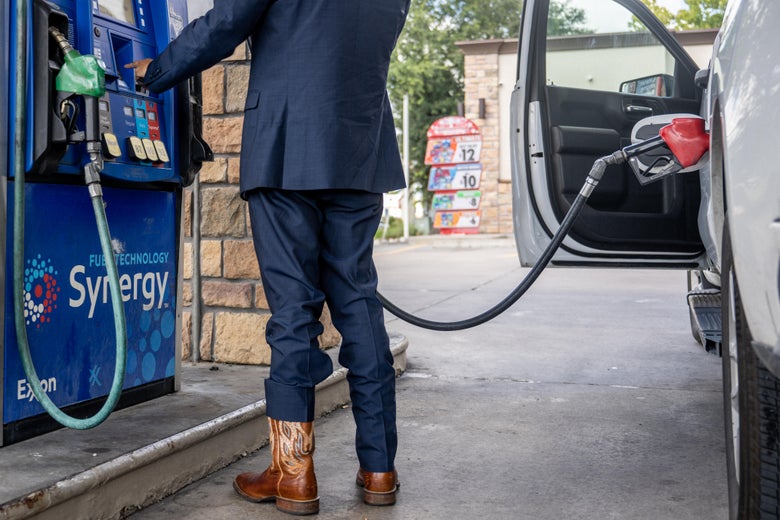
Some good news in this inflationary summer: Gas prices have finally been going down—and down, and down, and down some more. Fuel prices have now fallen for more than 50 days straight and are on track to sink by about 20 percent from June’s $5.02-per-gallon peak to a national average of $4; some states are already below that marker. Joe Biden is relieved, as are Americans, at least to judge by the president’s slightly improving ratings, even though gas prices are still at least 31 percent higher than they were at this time last year.
Although prices never hit the inflation-adjusted 2008 record, the very presence of the $5 price tag became a symbol of the nation’s inflation woes. But considering that the Consumer Price Index remains high for now, Russia is still at war with Ukraine, and fossil fuel companies keep counting record profits, it may not seem immediately clear what’s causing the current downswing. While there are actions the Biden administration has taken in the hopes of softening pain at the pump, the downward price trend in other countries points to factors outside U.S. governance (so don’t hand all the credit to Dark Brandon just yet). And some energy analysts and economists are warning not to expect this relief to continue, viewing it as a forerunner of broader economic tribulations. What’s really happening, and what happens next? Fill up your tank—or better yet, hop on your e-bike—and ride with me.
Dampened Demand
The most significant driver of the price drops? Demand, demand, demand. Multiple consumer surveys have found that the year’s cost surge motivated many American drivers to reconsider their primary means of transport—and to drive much less overall. According to AAA, there continues to be a reduction in work commutes, and families are also slowing down their retail shopping and restaurant dining habits. Plus, Americans are increasingly interested in hybrid and electric vehicles, although price hikes in even that sector have staved off widespread adoption (which could change, should the Inflation Reduction Act become law). Demand for, sales of, and uses for bicycles—both electric and not—have all heightened as even residents of oil-happy states avoid excessive gas combustion for shorter trips. It’s not just individualized transport: The Energy Information Administration stated Wednesday that aviation fuel consumption has dropped by nearly 20 percent over the past week, perhaps due to the recent spate of flight cancellations and airline troubles.
Crude Attitude
The EIA also noted Wednesday that the United States’ stockpiles of crude oil and gasoline rose over the past week. This may appear to be an unexpected development, since domestic production and refining capacity stayed about the same, but as an S&P analyst noted on Twitter, Biden’s emergency sales of barrels from the Strategic Petroleum Reserve likely helped oil companies bolster their holdings. This should help out stateside even in the midst of a diplomatic loss for Biden: OPEC+, the group of Gulf petrostates, only agreed to a small boost in its countries’ production of crude, despite the U.S. president’s in-person requests. Already, many of these nations aren’t meeting their agreed barrel-quantity targets, and their need to coordinate with Russian oil companies—which like higher oil prices, not least due to the economic hit of international sanctions on the country—limits how aggressively they can take action to increase supply and shrink market costs. The OPEC+ announcement led to a 1 percent increase in oil prices, which doesn’t really please either the U.S. or Russia. The barrel boost doesn’t really help your local gas station either, since refining capacity to turn oil into gasoline hasn’t bounced back from the COVID recession’s lows, no matter how much Biden has tried to change that. (The refinery shortage is also the cause of regional differences in gas prices: Many of the refineries that shut down in 2020 were concentrated in the Northeast, where current prices remain higher on average, while large Gulf Coast refineries have eased the supply crunch for the South.)
Squeezing the Economy
The EIA’s Wednesday reports fueled a decrease in the values of gasoline and oil futures to their lowest levels since February, when Russia invaded Ukraine. Currently, investors don’t seem as confident in the energy industry as they were earlier this year, thanks to recession fears sparked by the Federal Reserve’s interest rate hikes, which they think could keep oil demand low. Such pessimism is compounded by the slowdown in growth in both China and the U.S., two nations whose economic tribulations have adverse effects on the rest of the world. Worries over the potential for a global recession have persisted for a while now—and have concurrently spurred a monthslong decline in oil prices, which certainly helps at the pump. Still, if the Fed’s actions do induce a recession, gas-and-oil price relief will be cold comfort at best.
End of the Ride?
Some analysts caution that the gas-price comedown may be temporary at best. If Americans take today’s low prices as a cue to resume their pre-2022 driving habits, demand—and costs—might just blow right back up. If climate change–fueled storms hit the vulnerable Gulf of Mexico coast, Southern refineries might be forced to shut down, affecting local gasoline supply. And even if summer activities are down for now, personal transport and use of fossil fuel–based heaters will climb as weather gets colder, further straining oil supplies. There’s still a lot of uncertainty ahead, and long-term issues like the refinery shortage, Russia’s oil shocks, and a need for increased renewable energy capacity likely won’t be solved by the wintertime. So, enjoy the pump savings for now, but don’t bank on their longevity just yet.
from "price" - Google News https://ift.tt/UnrwKvj
via IFTTT
No comments:
Post a Comment